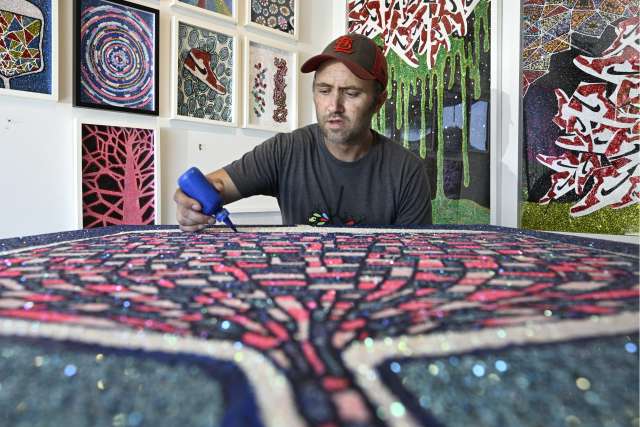Dylan Mortimer was diagnosed with cystic fibrosis at 3 months old. At the time, the life expectancy for those with the genetic condition was 14 years.
As treatments for CF have advanced, however, and through the generosity of organ donors, Mortimer is now 44.
A longtime artist, Mortimer has coped with his chronic condition – which affects the lungs and digestive system – by creating works of art. Now, he has a collection of pieces shimmering with glitter on display in the exhibit “Breath-Taking,” featuring the work of artists with cystic fibrosis, at the dnj Gallery in Santa Monica.
While the artistic process has been a therapeutic tool for Mortimer, he also hopes his paintings of medical supplies and body parts will bring awareness to the condition.
Cystic fibrosis led to a transplant
Cystic fibrosis is caused by a faulty gene that hinders a cell's ability to secrete smooth and slippery fluids. For those with the condition, their cells produce a thick, sticky mucus that blocks airways in the lungs, causing frequent infections. To prevent those infections, patients undergo a daily regimen of therapy to move mucus and bacteria out of their lungs.
Depending on the severity of the disease, patients may require antibiotics and hospitalization.
Mortimer received antibiotics during hospital stays growing up and was optimistic about his health despite increasing inpatient visits while in high school and college.
“I viewed my condition like a glass half full,” Mortimer said. “I was grateful for the life that I had more so than angry and upset at what I couldn’t and didn't do.”
While continuing to manage his disease, Mortimer got married and had two children. But in his early 30s, his health started to decline. Basic tasks, such as carrying a car seat up the stairs, were becoming harder to complete and hospital stays and the need for antibiotics increased.

After his lung function dipped from 50% to 30% over less than a year and after undergoing four embolizations – a procedure that halts blood flow to a certain area of the body – in one month, Mortimer’s health care team advised him to get a lung transplant.
He received new lungs at age 37, but nearly two years later, doctors told him his body was rejecting the organs.
“I was crushed,” Mortimer said. “I felt like I climbed a steep mountain, and then there was another one to climb.”
Mortimer developed a high antibody level after his first transplant, which made it more difficult to find a match the second time around because his immune system was sensitized to reject a foreign organ. He lived in New York City then, and his doctors recommended he get medical care at Duke University Hospital – with its wide donor pool and a cystic fibrosis center.
But during the transition of medical care, Mortimer received an unexpected, life-saving phone call.
A woman following Mortimer’s Instagram account, through which he was documenting his health journey, reached out to offer her cousin’s lungs. As her cousin, who was an organ donor, was dying, she discussed Mortimer’s need for a transplant with the family and they approved of the donation.
Knowing all the protocols and donor-recipient matching requirements involved in receiving a transplant, Mortimer assumed the woman’s offer would not go through.
The woman contacted his medical team and they determined the lungs were a match. He underwent his second lung transplant at age 39.
After a move to Los Angeles, Mortimer is now being treated by Grant Turner, MD, a pulmonary and critical care physician who is part of the Cystic Fibrosis Center at UCLA Health. Dr. Turner monitors Mortimer’s new pair of lungs and cystic fibrosis symptoms every three months.
“Theoretically, Mortimer’s lungs don't have cystic fibrosis anymore because of the lung transplant,” Turner said. “But people with CF also have issues with their sinuses and GI tracts.”
Art imitates life
Though Mortimer has been an artist much of his life – he even has a graduate degree in art – he did not start incorporating his health journey into his work until he was listed for a lung transplant.
“It got to a point where it didn’t feel honest if I didn’t bring my experience with cystic fibrosis into my visual art,” he said.
He started to paint IV bags, IV poles and face masks as symbols of hope.

“Needing these medical supplies was terrible and incredible at the same time because it saved my life,” he said. Mortimer also painted elements of the body, such as scars, cells and bronchial trees.
Creating art during the lowest points of his health was therapeutic and kept his spirit alive, Mortimer said. Though he is more stable now, he remains dedicated to spreading awareness through his craft.
“Losing your first transplant in two years is devastating, but because he has his art and his faith, he's able to remain calm,” Dr. Turner said.
Depending on the project, Mortimer says it takes about two weeks to a month to complete an art piece start to finish. He begins by drawing out the shapes, then pours glitter in the outlined spaces, and paints over the canvas. He works on several pieces at a time at his art studio in Long Beach.
One of his works in the “Breath-Taking” exhibit is a self-portrait in which he’s standing in front of lush palms and behind an IV pole. Mortimer said it’s meant to portray the contrast between living in a beautiful city like Los Angeles and the harsh reality of routinely relying on medicine to live.
“From being told I’m not going to make it past 14 to participating in an exhibit like this is incredibly meaningful,” Mortimer said.
The “Breath-taking” exhibit runs through June 22, but Mortimer plans to continue showing his work in other exhibits and advocate for hospitals to install art.
“My aim is to add inspiration, dignity and hope to replace stock art or blank walls in so many medical settings,” Mortimer said. “All science confirms that people heal faster, more effectively, and less expensively, once surrounded by uplifting and creative environments.”

